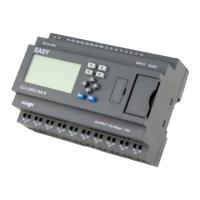xLogic SuperRelay User’s Manual
36
retentive functions and various parameter assignment options, which allow you to adapt
the circuit program to suit your own requirements.
This section provides you with a brief overview of input designations and with some
particular background information on SFs. The SFs in particular are described in
Chapter 4
3.3.1 Designation of the inputs
Logical inputs
Here, you will find the description of the connectors you can use to create a
logical link to other blocks or to the inputs of the xLogic unit.
S (Set):
A signal at input S sets the output to logical “1”.
R (Reset):
The reset input R takes priority over all other inputs and resets the outputs.
Trg (Trigger):
This input is used to trigger the start of a function.
Cnt (Count):
This input is used for counting pulses.
Fre (Frequency):
Frequency signals to be evaluated are applied to this input.
Dir (Direction):
This input determines the direction of count.
En (Enable):
This input enables a block function. When this input is “0”, other signals to the
block will be ignored.
Inv (Invert):
A signal at this input inverts the output signal of the block.
Ral (Reset all):
All internal values are reset.
Parameter inputs
At some of the inputs you do not apply any signals. You configure the
relevant block values instead. Examples:
Par (Parameter):
This input will not be connected. Here, you set the relevant block parameters

